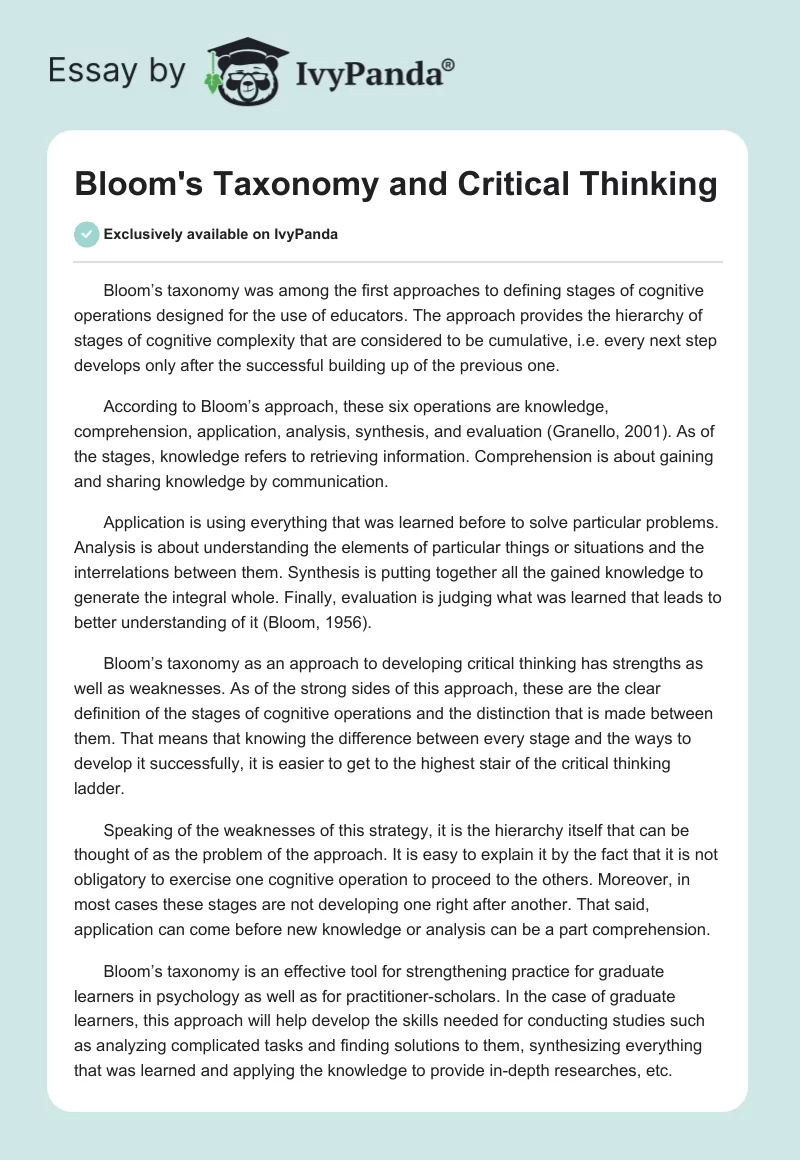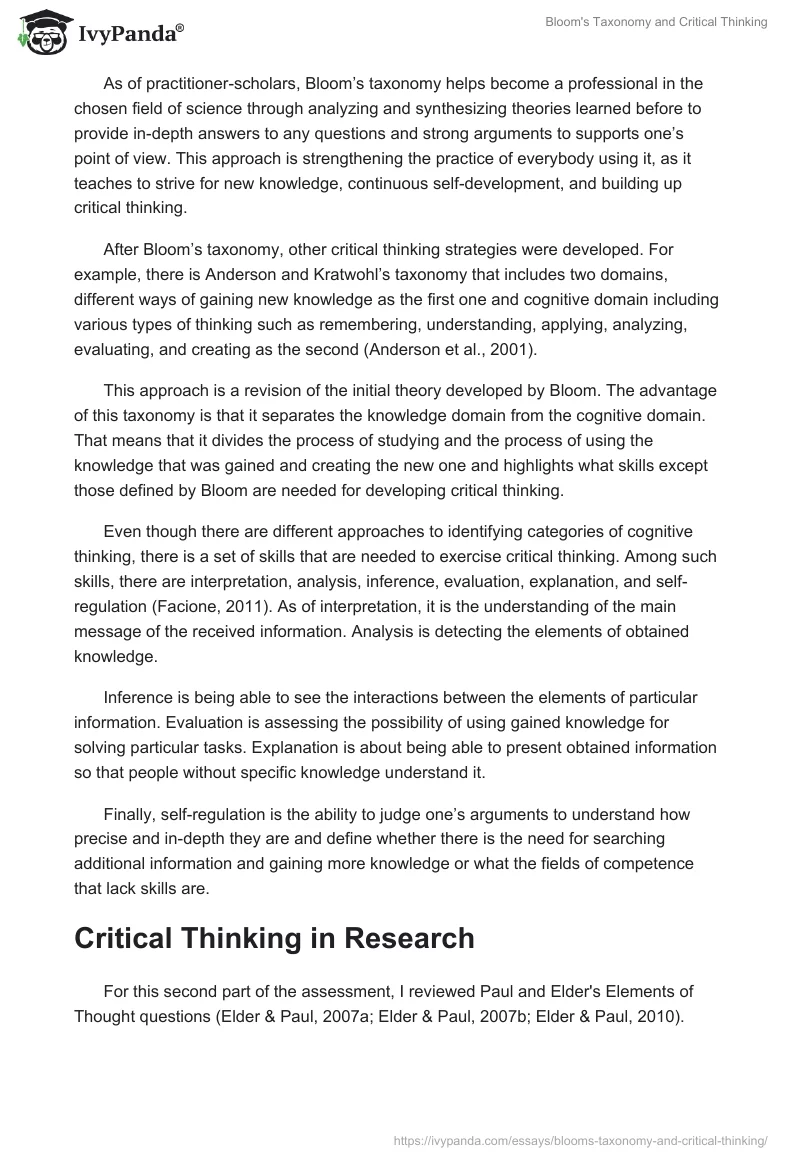Bloom’s taxonomy was among the first approaches to defining stages of cognitive operations designed for the use of educators. The approach provides the hierarchy of stages of cognitive complexity that are considered to be cumulative, i.e. every next step develops only after the successful building up of the previous one.
According to Bloom’s approach, these six operations are knowledge, comprehension, application, analysis, synthesis, and evaluation (Granello, 2001). As of the stages, knowledge refers to retrieving information. Comprehension is about gaining and sharing knowledge by communication.
Application is using everything that was learned before to solve particular problems. Analysis is about understanding the elements of particular things or situations and the interrelations between them. Synthesis is putting together all the gained knowledge to generate the integral whole. Finally, evaluation is judging what was learned that leads to better understanding of it (Bloom, 1956).
Bloom’s taxonomy as an approach to developing critical thinking has strengths as well as weaknesses. As of the strong sides of this approach, these are the clear definition of the stages of cognitive operations and the distinction that is made between them. That means that knowing the difference between every stage and the ways to develop it successfully, it is easier to get to the highest stair of the critical thinking ladder.
Speaking of the weaknesses of this strategy, it is the hierarchy itself that can be thought of as the problem of the approach. It is easy to explain it by the fact that it is not obligatory to exercise one cognitive operation to proceed to the others. Moreover, in most cases these stages are not developing one right after another. That said, application can come before new knowledge or analysis can be a part comprehension.
Bloom’s taxonomy is an effective tool for strengthening practice for graduate learners in psychology as well as for practitioner-scholars. In the case of graduate learners, this approach will help develop the skills needed for conducting studies such as analyzing complicated tasks and finding solutions to them, synthesizing everything that was learned and applying the knowledge to provide in-depth researches, etc.
As of practitioner-scholars, Bloom’s taxonomy helps become a professional in the chosen field of science through analyzing and synthesizing theories learned before to provide in-depth answers to any questions and strong arguments to supports one’s point of view. This approach is strengthening the practice of everybody using it, as it teaches to strive for new knowledge, continuous self-development, and building up critical thinking.
After Bloom’s taxonomy, other critical thinking strategies were developed. For example, there is Anderson and Kratwohl’s taxonomy that includes two domains, different ways of gaining new knowledge as the first one and cognitive domain including various types of thinking such as remembering, understanding, applying, analyzing, evaluating, and creating as the second (Anderson et al., 2001).
This approach is a revision of the initial theory developed by Bloom. The advantage of this taxonomy is that it separates the knowledge domain from the cognitive domain. That means that it divides the process of studying and the process of using the knowledge that was gained and creating the new one and highlights what skills except those defined by Bloom are needed for developing critical thinking.
Even though there are different approaches to identifying categories of cognitive thinking, there is a set of skills that are needed to exercise critical thinking. Among such skills, there are interpretation, analysis, inference, evaluation, explanation, and self-regulation (Facione, 2011). As of interpretation, it is the understanding of the main message of the received information. Analysis is detecting the elements of obtained knowledge.
Inference is being able to see the interactions between the elements of particular information. Evaluation is assessing the possibility of using gained knowledge for solving particular tasks. Explanation is about being able to present obtained information so that people without specific knowledge understand it.
Finally, self-regulation is the ability to judge one’s arguments to understand how precise and in-depth they are and define whether there is the need for searching additional information and gaining more knowledge or what the fields of competence that lack skills are.
Critical Thinking in Research
For this second part of the assessment, I reviewed Paul and Elder’s Elements of Thought questions (Elder & Paul, 2007a; Elder & Paul, 2007b; Elder & Paul, 2010).
The authors are writing from the point of view that thinking is an inexplicable part of human nature. That means that everybody thinks; the only difference between people is in the depth of their thoughts and the ability to understand others. The authors claim that every thought consists of such elements as the point of view, purpose, question at issue, information, concept, interpretation and interference, implications and consequences, and assumptions (Elder & Paul, 2007b).
What is more, they believe that there are several quality standards that should be kept to if one wants to develop the ability of critical thinking. These standards are clarity, accuracy, precision, relevance, depth, breadth, logic, and fairness (Elder & Paul, 2007a).
That said, critical thinking is about asking oneself questions about whether the thought he or she is going to share with others suits all the standards of thinking and has all the elements of thought mentioned above. The authors support every thought by clear descriptions and examples so that it is easy to understand their point of view.
The authors’ theory is relevant to conducting in-depth studies and implementing the ideas in every field of science, and psychology is not an exception. Bearing in mind everything learned from Elder and Paul is an effective way of creating comprehensive studies and developing critical thinking.
Integrating their approach with Bloom’s taxonomy can make the process of exercising critical thinking even easier. The only thing to remember in this incorporation is that every next stage of cognitive complexity defined by Bloom should include more complicated elements of thoughts and stick more strictly to the quality standards developed by Elder and Paul.
References
Anderson, L.W., Krathwohl, D. R., Airasian, P. W., Cruikshank, K. A, Mayer, R. E., Pintrich, P. R, … Merlin C. Wittrock. (2001). A taxonomy for learning, teaching, and assessing: A revision of Bloom’s taxonomy of educational objectives. New York, NY: Pearson.
Bloom, B. S. (1956). Taxonomy of educational objectives, handbook I: The cognitive domain. New York, NY: David McKay.
Elder, L., & Paul, R. (2007a). A thinker’s guide to analytic thinking. Dillon Beach, CA: Foundation for Critical Thinking.
Elder, L., & Paul, R. (2007b). Foundation for critical thinking: Online model for learning the elements and standards of critical thinking. Web.
Elder, L., & Paul, R. (2010). Universal intellectual standards. Web.
Facione, A. P. (2011). Critical thinking: What it is and why it counts. Web.
Granello, D. H. (2001). Promoting cognitive complexity in graduate written work: Using Bloom’s taxonomy as a pedagogical tool to improve literature reviews. Counselor Education & Supervision, 40(4), 292–307.


